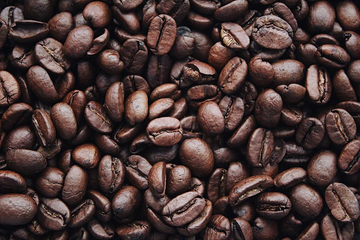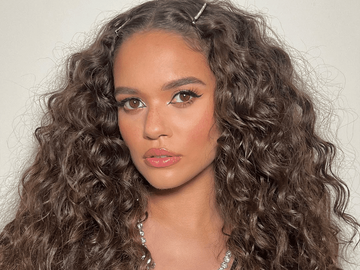If you've ever spent precious time wielding a flat iron only to step outside and see your sleek locks transform into a frizzy mess, you're not alone. But fear not, because we've got some tricks up our sleeve to help you keep your hair shiny and straight, no matter how high the humidity climbs.
With a few tips and a bit of know-how, you can keep that frizz at bay and maintain your straightened style for longer. Read on to find out how to keep your hair smooth and frizz-free even when the weather is doing its best impression of a tropical rainforest.
Why does humidity cause frizz?
When the air is humid, it means there's a high level of moisture in the atmosphere. Your hair is made up of proteins, and these proteins have a unique structure. When the air is humid, water molecules in the air are attracted to those protein structures in your hair.
When your hair absorbs moisture from the air, each strand swells up. This is because the hydrogen bonds in the protein structure of your hair interact with the water molecules, causing the hair shaft to expand. And when your hair shaft expands, it doesn't stay in that sleek, straight formation you worked so hard to achieve with your flat iron. Instead, it becomes frizzy and unruly. Humidity causes your hair to absorb moisture from the air, which disrupts the protein structure of your hair strands, leading to frizz.
This isn’t just the case for curly hair, either. All hair types, including naturally straight hair, can get frizzy when it’s wet or humid out, and certain other factors can make it worse. If you’ve already got some damage from over-styling, processing, or using a lot of harsher products on your hair, you might see more frizz than the average person. People with curly or fine hair also tend to get more frizziness.
Additionally, if you have more porous hair, you’ll likely experience more frizz. How can you tell if your hair is more porous? Porous hair absorbs moisture more readily, like a sponge, and if your hair has a higher porosity, it’ll do that with the moisture in the air. Take a strand of your hair and put it in a cup of water. If it sinks to the bottom of the cup immediately, chances are, your hair is pretty porous. If it stops in the middle of the cup, you likely have a normal level of porosity.
No matter what’s going on with your hair, the good news is, you can get it straight and sleek, and keep it that way all day long with the right tools, tips, and tricks.
How can I keep my hair frizz-free when it’s humid?
If you’ve ever chosen to forego the flat iron or just tossed your hair into an updo when you’ve realized how humid it is outside, we feel you. There’s nothing worse than spending hours doing your hair, only to have all your hard work undone as soon as you step outside. But if you follow the steps below, from your shower to your bedtime routine, you can get your hair to stay sleek all day, even if it’s super humid.
Start your mission in the shower
The fight against frizz starts right from the very beginning of your haircare routine, so set yourself up for success while you’re in the shower.
Step 1: Choose a shampoo and conditioner specifically designed to fight frizz. Look for products that are sulfate-free and contain moisturizing ingredients like argan oil or shea butter. These help to keep your hair hydrated and less prone to frizz. When you're applying conditioner, focus on the lengths and ends of your hair, avoiding the roots so they don’t get weighed down.
Step 2: As tempting as a hot shower might be, rinse your hair with cool water instead. Cool water helps to seal the hair cuticle, keeping moisture locked in and reducing frizz. Plus, it's a refreshing way to wake up in the morning.
Step 3: When you're done showering, resist the urge to vigorously rub your hair with a towel. Instead, gently squeeze out excess water and wrap your hair in a microfiber towel or an old T-shirt. These materials are much gentler on your hair and absorb moisture without causing friction, which can lead to frizz.
Prep your hair for styling
After you’ve washed your hair and towel dried it as per our steps above, apply a fizz-fighting product to your damp hair. Look for a smoothing serum, cream, or oil that's formulated to tame frizz and add shine. Start with a small amount—about a dime-sized dollop for medium-length hair—and distribute it evenly from mid-lengths to ends. This helps to seal the hair cuticle and create a barrier against humidity.
If you're planning to use heat styling tools like a blow dryer or flat iron, it's crucial to protect your hair from heat damage. Apply a heat protectant spray or serum to your hair before styling to create a barrier that shields your strands from high temperatures.
Before styling, detangle your hair with a wide-tooth comb or a detangling brush. Start from the ends and work your way up to the roots, being gentle to avoid causing breakage or frizz. This step helps to make sure that your hair is smooth and knot-free before you start styling.
Style your hair

Now that your hair is prepped and ready to go, it's time to style it like a pro. Here's how to style your hair to fight frizz and achieve that smooth, sleek look.
Step 1: If you’re going to straighten your hair with a flat iron, make sure your hair is completely dry first. Wet or even damp hair is a lot weaker than dry hair, which means if you apply heat to it, it’s going to be a lot more vulnerable. If you can let it air dry about half-way before hitting it with the blow dryer, that’s ideal.
Step 2: Choose styling tools that are gentle on your hair and help minimize frizz. A titanium flat iron can work wonders for straightening hair, while a diffuser attachment for your blow dryer is great for enhancing natural waves or curls without causing frizz.
Step 3: When using heat styling tools, opt for a low to medium heat setting. High heat can damage your hair and make it more prone to frizz. Remember, you can always increase the heat if needed, but it's better to start low and gradually increase as necessary.
Step 4: Divide your hair into small sections before styling. This allows you to focus on one section at a time, ensuring that each strand gets properly straightened or styled, and also that you’re not passing over the same section unnecessarily. Use clips or hair ties to keep the sections you're not working on out of the way.
Step 5: Whether you're using a flat iron, blow dryer, or curling iron, use smooth, even strokes to style your hair. Avoid jerky movements, as these can cause frizz and uneven results. For straightening, slowly glide the flat iron down each section of hair, applying even pressure from root to tip. If you're using a blow dryer, use a round brush to smooth out your hair as you dry it, working from roots to ends.
Step 6: Once you've styled a section of hair, allow it to cool before moving on to the next section. Cooling down helps to set the style and seal the hair cuticle, reducing frizz and helping your style last longer.
Step 7: After styling, apply a small amount of anti-frizz serum, cream, or oil to your hair to lock in moisture and keep frizz at bay. Focus on the mid-lengths and ends, where frizz tends to be most noticeable. You can also set your style all over with some light hairspray, ideally one that’s also anti-frizz. Just do your best to avoid applying too much product, as this can weigh your hair down and make it look greasy.
Now that you’ve styled it, it’s always best to try to extend that style so you don’t need to reapply heat every day. And you definitely should try to avoid washing it every day. Overwashing is one of the biggest contributors to dry and frizzy hair.
Ideally, when you wake up in the morning with your day-two hair, apply some dry shampoo to your roots, blast it with your hair dryer, and brush it through your hair. If you do have some bends throughout your hair and you feel like you want to flatten them out a bit, pop your flat iron on a low heat setting and try to focus on just the parts that need it.
Sleep on silk
You’ve likely heard this beauty tip before, but trading in your cotton or synthetic pillowcase for a silk one is amazing for your skin and your hair. It’s about so much more than feeling luxurious, and it can actually be a game-changer for fighting frizz. Here's why:
– Reduced friction. Silk is super smooth, unlike other fabrics like cotton, which can be rough on your hair. When you sleep on a silk pillowcase, your hair glides over the surface rather than rubbing against it. This reduces friction, preventing tangles and minimizing frizz.
– Preserves moisture. Cotton pillowcases can absorb moisture from your hair, leaving it dry and more prone to frizz. Silk, on the other hand, doesn't absorb moisture as much, so your hair retains its natural oils and hydration. This helps keep your hair moisturized and less likely to frizz up.
– Gentle on strands. Silk is gentle on your hair strands, reducing breakage and split ends. When your hair is less damaged, it's better equipped to resist frizz, resulting in smoother, healthier-looking locks.
– Maintains style. Ever wake up with a hairstyle that's gone rogue overnight? Silk pillowcases help maintain your hairstyle while you sleep. Whether you've straightened, curled, or styled your hair, sleeping on silk helps keep your hair in place, reducing the need for excessive styling the next day.
– Less static. Silk has natural anti-static properties, meaning it reduces static electricity in your hair. This helps prevent your hair from standing on end and looking frizzy, especially in dry conditions or during the winter months.
By swapping out your regular pillowcase for a silk one, you're giving your hair a better environment to rest in. You'll wake up with smoother, shinier hair that's ready to take on the day.
If you want to up the ante and wake up to even healthier, shinier hair, apply a leave-in conditioner or hydrating hair mask to your lengths before bed, ideally the night before you plan to wash your hair. Choose one with ingredients like coconut or argan oil, and apply it throughout your hair, focusing on the ends and anywhere that needs a little extra love. Then, double down on the silk: wrap it in silk to help lock in that moisture.
Consider chemical straightening

Chemical straightening, also known as a "perm" or "relaxer," is a hair treatment method used to permanently or semi-permanently straighten curly or wavy hair. If you’ve got really curly or coarse hair, it can be a great option to keep it straight, no matter the weather.
Here's how it works:
Breaking down bonds: The first step in chemical straightening is applying a solution to the hair. This solution typically contains strong chemicals like sodium hydroxide (lye), ammonium thioglycolate, or guanidine hydroxide. These chemicals work by breaking down the bonds in the hair's protein structure, called disulfide bonds.
Restructuring hair bonds: Once the bonds are broken, the hair is straightened and stretched to the desired shape. For permanent straightening, the hair is typically pulled taut and coated with a chemical solution. The solution is then left on the hair for a specific amount of time to restructure the bonds in the straightened position. For semi-permanent straightening, the hair may be wrapped around rods or rollers to create a looser, wavier texture.
Neutralizing: After the hair has been straightened or retexturized, a neutralizing solution is applied to stop the chemical process. This solution helps to re-form the broken bonds in their new configuration, locking the hair into its straightened state. Without neutralizing, the hair could revert to its original texture.
Rinsing and conditioning: Once the neutralizing process is complete, the hair is thoroughly rinsed to remove any remaining chemicals. A deep conditioning treatment is often applied to restore moisture and nourishment to the hair, as chemical straightening can be drying and damaging.
Maintenance: Chemically straightened hair requires special care to maintain its condition and prevent damage. This includes using sulfate-free shampoos and conditioners, minimizing heat styling, and regular deep conditioning treatments.
It's important to note that chemical straightening is a permanent or semi-permanent process, depending on the type of treatment used. While it can provide long-lasting straightening results, it also involves strong chemicals that can damage the hair if not applied correctly or if the aftercare isn't followed diligently. Consulting with a professional stylist who is experienced in chemical treatments is always a good idea to achieve the best results and keep your hair healthy.
Take care of your tresses
Whether you’re flat ironing your hair, blow drying it straight, or going the more permanent route, there’s no reason frizz should get in your way now that you’re armed with the advice, products, and tools to fend it off.
As always, remember to give your hair a break from heat styling as often as you can, and embrace your natural texture. Your hair will look gorgeous and sleek straight, but we bet when it’s living its best (healthy!) life, you’ll learn to love how it falls on its own, too.





